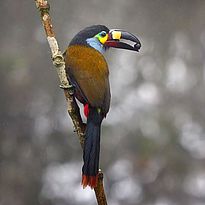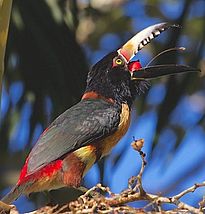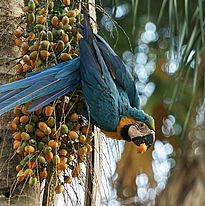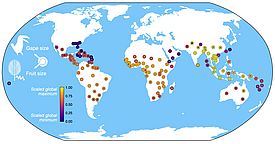24.02.2022 | Beate Kittl | News WSL
Areas of the globe where fruit-eating birds have wider beaks also have larger palm fruits, a new study shows. This sounds banal, but it provides new insights into tropical biodiversity and clues for solving species conservation, forest restoration and animal reintroduction challenges.
The biodiversity in tropical forests is enormous. But how did it come into being? In view of the large-scale destruction of such forests, this is a pressing question in ecological research. An international team led by the Swiss Federal Institute for Forest Snow and Landscape Research WSL has now explored how interactions between birds and palms may have increased biodiversity.
Most palm species produce fleshy fruits that are eaten by birds and mammals, which afterward spread the seeds. Birds often swallow fruits whole, and thus the width of their beaks limit the size of fruits they can consume. "Fruit-eating birds and palm trees have likely interacted for millions of years," explains Dr. Ian McFadden from the WSL Spatial Evolutionary Ecology group. He is first author of the study, which has now been published in the journal Ecology Letters. With his colleagues, McFadden created the first global map that connects the beak opening or gape widths of birds and the size of palm fruits. "Typically, species interactions are studied locally or regionally - we looked at this on a global scale using measures of bird beaks and palm fruit sizes," says McFadden.
Two recently-published datasets made this study possible: the AVONET database, which contains trait measurements for nearly all bird species worldwide, and PalmTraits, a comprehensive trait database for palm species. For the analysis, McFadden included over 1100 fruit-eating bird species and 2000 fruiting palm species. Using statistical path models, the researchers assessed how the relationship between beak widths and fruit sizes was affected by factors such as climate, plant biomass production, species richness and Earth’s tectonic history.
Stronger matching near the equator
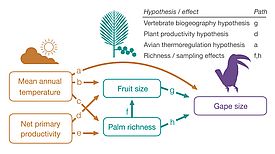
It turned out that the closer the species lived to the equator, the more closely bird and fruit traits were matched. This pattern was strongest for Africa, but weaker on islands such as Madagascar. On that island there are fewer fruit-eating birds but many lemurs that eat fruits, which may weaken the bird-palm matching pattern there, McFadden suspects.
The tighter coupling between bird beaks and palm fruits near the equator was found all over the world, although actual beak and fruit sizes differed between continents. Bird and palm trait sizes were overall largest in Southeast Asia, smallest in the Southeastern US and medium-sized in South America and Africa. In the model, climate did not directly influence how strongly beaks and fruits were correlated but did have indirect effects via palm diversity, which is higher in warmer tropical regions.
Studying the interconnectedness of trees and seed dispersers is also one way to guide practical nature conservation. "If you want to restore degraded forests, you also have to take seed-dispersing animals into account and, if necessary, reintroduce them", McFadden says. After all, the majority of fruits in the tropics are dispersed by animals.
According to the biologist, the study provides support for the hypothesis that the tropics have such high biodiversity in part because species interactions are stronger there. This finding increases our basic understanding of tropical forests and can help to find optimal leverage points for their protection. However, McFadden adds, "we still don't know whether tropical rainforests function in the same way across continents in regards to seed dispersal."
Contact
Original publication
McFadden et al. 2022 Ecology Letters. ‘Global plant-frugivore trait matching is shaped by climate and biogeographic history.’ https://doi.org/10.1111/ele.13890
Copyright
WSL and SLF provide image and sound material free of charge for use in the context of press contributions in connection with this media release. The transfer of this material to image, sound and/or video databases and the sale of the material by third parties are not permitted.
